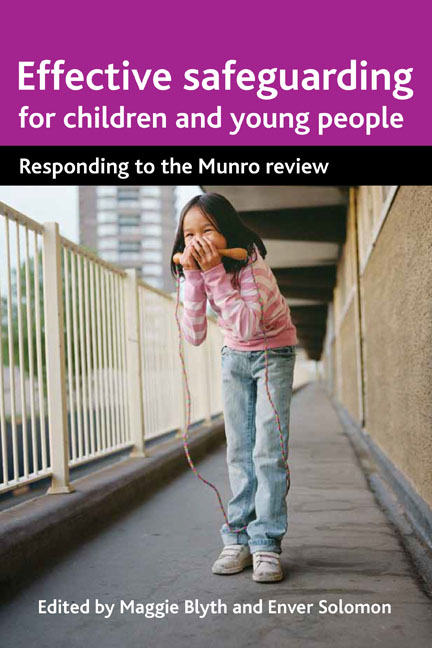Book contents
- Frontmatter
- Contents
- List of abbreviations
- Notes on contributors
- Acknowledgements
- Foreword
- one Early intervention
- two Local safeguarding children boards: faith, hope and evidence
- three The child's voice in the child protection system
- four Parental mental health, risk and child protection: what does Munro mean to child protection and adult mental health?
- five Adolescent-to-parent abuse and frontline service responses: does Munro matter?
- six Older children and the child protection system
- seven Serious case review
- Conclusion Conclusion
- Index
Conclusion - Conclusion
Published online by Cambridge University Press: 07 September 2022
- Frontmatter
- Contents
- List of abbreviations
- Notes on contributors
- Acknowledgements
- Foreword
- one Early intervention
- two Local safeguarding children boards: faith, hope and evidence
- three The child's voice in the child protection system
- four Parental mental health, risk and child protection: what does Munro mean to child protection and adult mental health?
- five Adolescent-to-parent abuse and frontline service responses: does Munro matter?
- six Older children and the child protection system
- seven Serious case review
- Conclusion Conclusion
- Index
Summary
Since the tragic death of Victoria Climbié in 2000, the child protection system has been subject to constant public and political scrutiny. Laming's damning indictment that there was ‘widespread organisational malaise’ (Laming, 2003) led to new legislation and a fundamental overhaul, with the creation of children's services, local safeguarding children boards (LSCBs) and procedural reform, including the publication of interagency guidance Working together to safeguard children (DfE, 2010). These changes had barely begun to be implemented when further proposals were made by another inquiry following the death of Baby Peter in 2007. The emphasis was more on workforce reform in order ‘to translate policy, legislation and guidance into day-to-day practice on the frontline of every service’ (Laming, 2009). It was expected that these reforms would be given some opportunity to bed down. But this wasn't to be.
In May 2010, the Coalition government appointed a children's minister, Tim Loughton, with a keen interest in the child protection system. In opposition, he had set up a Commission on the Future of British Social Workers which reported to the second Laming Inquiry that ‘no amount of reforms and procedures will succeed unless they free up properly trained, motivated and resourced social workers and other key professionals to get on with their job of working with families at the “sharp end”, based on maximising quality face to face time with the vulnerable families’ (Conservative Party, 2009). In government, Loughton has instigated a significant policy shift on the basis that ongoing reforms borne out of tragedy have not helped frontline child protection workers do their job better. Instead, they have hindered them:
Over the years, individual child tragedies have prompted national reviews and inquiries, resulting in calls for action. In response, legislation has been passed; rulebooks have expanded; more procedures and processes have been introduced and structures have been changed. But the fundamental problems have not gone away. Despite the very best of intentions, hard-working social workers, foster carers and other frontline professionals are, too often, still not able to make the difference they want to for vulnerable children and families. Day in day out they are up against a system that simply does not help them to do their best for children. (DfE, 2011a: 2)
Not surprisingly, shortly after taking office, Loughton asked Professor Eileen Munro to undertake a further independent review of the child protection system.
- Type
- Chapter
- Information
- Effective Safeguarding for Children and Young PeopleWhat Next after Munro?, pp. 145 - 154Publisher: Bristol University PressPrint publication year: 2012

